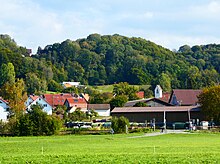Schweinhausen
|
Schweinhausen
Municipality Hochdorf
|
|
|---|---|
| Coordinates: 48 ° 2 ′ 15 ″ N , 9 ° 48 ′ 9 ″ E | |
| Height : | 555 m above sea level NN |
| Incorporation : | 1st January 1975 |
| Postal code : | 88454 |
| Area code : | 07355 |
Schweinhausen is a part of the municipality of Hochdorf in the Biberach district in Upper Swabia .
description

"Suenhusen" around 1142 or "Sweinhusen" (ahd. Swein. = Knappe, Knecht) written around 1185 is a hyphenated place that was probably created at the time of the Merovingian conquest in the 7th century. There are no objects or written documents from the Merovingian row graves that were allegedly found during the construction of the southern railway . Only in the hamlets Busen- (1521) and Wettenberg (1437) belonging to Schweinhausen on the high ground can it be assumed that they are medieval clearing settlements.
In the 12th century, a lower nobility named themselves after the place Schweinhausen. They could also have been the builders of the abandoned Schweinhausen Castle . Around 1124 the emperor confirmed Heinrich von Schweinhausen as part of the monastery of Ingoldingen and Degernau.
King Philip of Swabia and Irene of Byzantium spent their honeymoon at Schweinhausen Castle until September 1197 after their wedding, which is said to have taken place near Augsburg in May 1197. A certificate from Philip, issued on July 30, 1197 in Schweinhausen ( aput Swenhusen ), has been preserved from this time .
The town and castle later became Habsburg-Austrian before the rule was pledged to the Waldburg Truchsessen in 1520. In these documents from the year 1520 an office Schweinhausen is mentioned, whose Ammannen office was held in 1608 by the Tafernwirt von Schweinhausen. In the 15th century the castle fell into disrepair and in the 17th century it was finally demolished, the stones from the castle and chapel used to build the Heinrichsburg in the Eberhardzell area. In 1582 the Waldburgers set up a customs post on the territory of Schweinhausen opposite the free imperial city of Biberach. In terms of the church, Schweinhausen was looked after from Ummendorf.
After 1806 Schweinhausen came to the patrimonial office of Waldsee, later to the royal superior office of Waldsee and in 1938 to the district of Biberach .
On January 1st, 1975 Schweinhausen was incorporated into Hochdorf.
coat of arms
Blazon : Divided; above in gold a standing black lion, below in black a continuous golden cross. The lion refers to the dukes of Swabia and the Waldburgers. The golden cross reminds of the diocese of Rottenburg and the bishop Sproll who was born here.
Buildings
- Schweinhausen Castle (Burgstall)
- Parish Church of the Assumption
Sons and daughters of the place
- Alfons Hug (* 1950), curator , art critic and exhibition organizer
- Bishop Joannes Baptista Sproll , son of a street guard and resistance fighter against the Nazi regime
literature
- Country descriptions of the Sigmaringen State Archive: The Biberach District Volume II . Ed .: Landesarchivdirektion Baden-Württemberg in connection with the district of Biberach. Jan Thorbecke Verlag, Sigmaringen 1990, ISBN 3-7995-6186-2 , p. 85 ff .
Web links
Individual evidence
- ↑ Maria Magdalena Rückert: Irene-Maria, wife of Philip of Swabia, and her children. In: Karl-Heinz Rueß (Ed.): Frauen der Staufer , Göppingen 2006, pp. 74–89, here: p. 77.
- ↑ WUB Volume 2, No. 502 .
- ^ Federal Statistical Office (ed.): Historical municipality directory for the Federal Republic of Germany. Name, border and key number changes in municipalities, counties and administrative districts from May 27, 1970 to December 31, 1982 . W. Kohlhammer, Stuttgart / Mainz 1983, ISBN 3-17-003263-1 , p. 546 .

